|
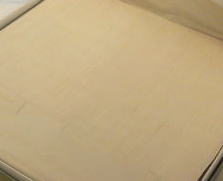 |
越後上布、宮古上布、小千谷縮等でおなじみの苧麻です。からむしとも言います。左写真は韓国の 韓三モシです。 This plant is known as the material for Echigo-joufu,Miyako-joufu,Odjiya-chidjimi.It is also calld"karamushi″.The photo is hanzan-moshi in Korea. |
|
 |
越後上布、宮古上布、小千谷縮等でおなじみの苧麻です。からむしとも言います。左写真は韓国の 韓三モシです。 This plant is known as the material for Echigo-joufu,Miyako-joufu,Odjiya-chidjimi.It is also calld"karamushi″.The photo is hanzan-moshi in Korea. |
| 工程 Process |
作業内容 How |
写真とコメント Photos and coments |
|
| 1 | 刈り取り Gathering the ramies |
7~8月の早朝に刈り取った苧麻の葉を落とし、流水に浸ける。 In the early morning of July and August the stems of the ramie are cut off and soaked in the running water. |
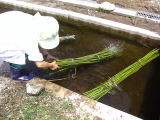 |
| 2 | 皮はぎ Stripping the skin |
芯を抜いて皮を剥ぎ、水に浸ける。 The skin of the stem is stripped off the core and soaked in the water. |
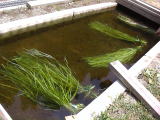 |
| 3 | 苧引き Scraping the outer skin |
板の上で、金属の道具を使って表皮をこそげ落とす。 The outer skin is scraped off on a wooden board with a metal scraper. |
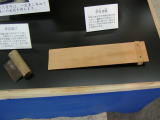 右、しなりの良い檜製の「苧引き板」の上で左の「ヒキゴ」などと呼ばれる鉄のスクレイパーで表皮を掻き落とす。 右、しなりの良い檜製の「苧引き板」の上で左の「ヒキゴ」などと呼ばれる鉄のスクレイパーで表皮を掻き落とす。Right is a board made of Japanese cypress ,on which the outer skins of ramies are scraped with an iron scraper as is shown on the left of the photo. It is called "hikigo" or other names. 上のような道具がなくても大丈夫!あるものを使うのがみちくさ流。竹を割ったものと、木の板があれば十分。 Do not worry if you have no tools like above. A scraper which is not so sharp and a long wooden board are enough for the process. 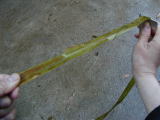 1.剥いだ皮の裏側から割り竹でしごく。 Rub the inside of the skin with a split piece of bamboo. 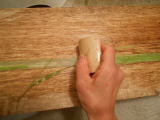 2.皮を板にのせて表皮を割り竹でこき落とす。 2.皮を板にのせて表皮を割り竹でこき落とす。2.Scrape the outer skin off on the board. 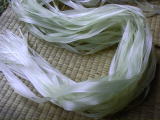 左は引き終わった繊維。状態の良いものは光り輝いています。 Left is finished ramie fiber.Those in good condition has a luster on them. |
4 |
績む Ply-joining the strings |
繊維を目的の太さに裂き、一本一本を撚り繋いでいく。 (績むってなあに?Ⅲ→) The fiber is separated to be the needed thickness. The tip end of the one string and the base end of another string are ply-joined to be a long string. (What is ply-joining ?Ⅲ→) |
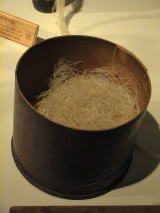 昔は木製の「苧桶オボケ)という容器に績み終わった苧麻糸を入れていました。 昔は木製の「苧桶オボケ)という容器に績み終わった苧麻糸を入れていました。In the past the ply-joined string was put in a wooden box called "oboke″ |
| 5 | 撚りかけ. Twisting the string |
糸車で撚りを掛ける。 The string is twisted with the twister wheel. |
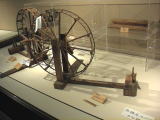 |
| 6~ | 製織、等 Weaving ,etc. |
織りの工程は製品によっていろいろです。 The process of weaving is different according to the aim of the work. |